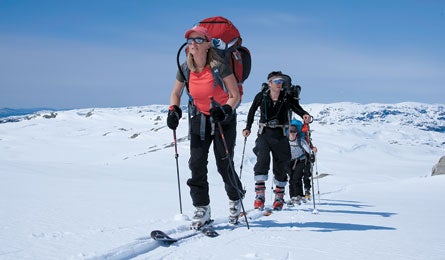Norway: Tested

'Gear Editor Kristin Hostetter leads the team across the Folgefonna Glacier. (Berne Broudy)'
What do the Grand Canyon, the pyramids of Egypt, Yosemite’s Half Dome, and the Sistine Chapel have in common? Nothing you’ve seen before prepares you for these one-of-a-kind wonders. To that list you can add the fjordlands of western Norway, where mountains crowd peak-to-glacier and then drop precipitously into the sea, and the land splits into a jigsaw puzzle of deep fjords and myriad islands. You might have seen all of the pieces before, but never like this: all in one place, with a hut system we wish we could take home.
Here, the Folgefonna Glacier lies less than 15 miles from Hardangerfjorden, a deep-water fjord–the third-largest in the world. The 85-square-mile Folgefonna is a plateau glacier, so it’s flat on top, while blue-ice crevasses and ice-melt creeks riddle its steep sides. You can rappel into the crevasses on a day trip or do overnight ski tours on the glacier (see Plan It to left).
Our test crew crossed the glacier during a week of skiing and hiking in the region. The traverse took three days, but measuring springtime in Norway by “days” is misleading. The near-midnight sunsets make it seem like a winter adventure in midsummer–and each day feels twice as long as normal. In one 24-hour period, we skinned up to the glacier’s 5,452-foot highpoint on North Folgefonna (the glacier is divided into sections: North, Middle, South); crossed the Arctic-flat plateau; scramble-skied down a maze of corn-snow gullies to a valley at the edge of South Folgefonna; and still had time to pitch a sweet camp overlooking a frozen lake–and then linger over a sunset that seemed stuck on pause.
The next day we climbed again, skinning up a long but moderate grade to the top of South Folgefonna. For those who like backcountry skiing for the solitude as well as the thrill, this journey delivers: Our isolation was total on a vast white expanse that stretches from horizon to horizon; and each day included descents that ranged from easy-fun to scary-fun (the latter can be avoided by taking the more standard route down, at the far southern end near Rosendal). We even did evening laps in shin-deep powder on a slope near Holmaskjer, one of two huts on South Folgefonna. From it, we could see over countless ridges to the fjord-sliced coast and the North Sea.
Norway’s extensive hut system (see p. 16) makes it easy to travel without camping gear, which is the way most skiers cross Folgefonna. Of course, one of our crew still pitched a tent in whipping wind outside the shelter (testing!), but even he came inside for reindeer stew. Verdict? Like fjordland itself, nothing compares.